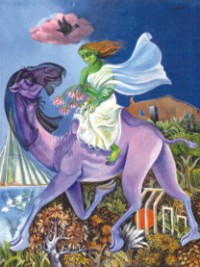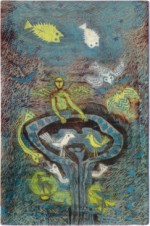| Home - Back Issues - The Team - Contact Us |
 |
| Volume 10 |Issue 13 | April 01, 2011 | |
|
|
Art Cornucopia of Colours Fayza Huq
The ninth gathering of Bengal's “Rooted Creativity” was as exciting as the others before. Nazlee Laila Mansoor was the senior most artist of the occasion. During the press conference the artists said their bits with wit, interlacing their observations with interesting anecdotes. Poised, bursting with confidence and maturity they introduced their styles and themes with panache. Including Nazib Mohammad, Rezaun Nabi and Mokhlesur Rahman, and stretching on to Kazi Salauddin Ahmed, Amirul Momanin Chowdhury, the flamboyant and fascinating group of ten artists had young and iconoclastic Niloofar Chaman and Tayeba Begum Lipi to complement the culled collection of prominent artist. Golam Rabbani, the youngest of the participants, completed this spectacular fanfare of visual art. In Nazlee Laila Mansoor's 'Adbhut Ut' (Strange Camel) one is faced with a woman with a wasted, eerie, ashen face, carrying wilted water lily blossoms. She sits atop a camel, a black veil covering the camel's head; she appears to be wrapped in fear and agony. Symbols of the language movement and the liberation war present the artist's brilliant Op Art version of the half-hearted and lackadaisical progress of woman in the country. In the clustering of forms and figures are “kash” flowers and banana leaves. The work is a detailed burst of colours, a development of our rickshaw art. The Chittagong School of artists have always been intense presenting paintings with their layers of meaning. The formidable group have concentrated more in driving home their sense of values, and evaluation of the social and political assessment of their surrounding scenario. To decorate the drawing room was never Nazlee's aim. Crows, dead and dying women, and apparently unsympathetic nature have repeatedly crowded Mansoor's acrylic covered canvases. The horrific images leave an indelible mark on the mind of the viewer. Man seen against the backdrop have been the repeated themes of all good artists through the years. What “man has done to man” is the repeated preoccupation in Mansoor's mind. Mansoor is well aware that the collection of haunting, nightmarish images might be considered disturbing by some. Yet the plight of the country and particularly its woman, is not something to be swept under the carpet. The elements of despair and agony in Mansoor's works, an integral part of the past and future of the country are unsurpassed in her phantasmagoria world. Her work is not surrealistic but the fear and horror elements are unsurpassed. Facile, superficial beauty in shape and colours were never her aim. Mansoor is not threatening or intimidating. She is only spelling out the truth and the inevitable. She does not paint to please the art market. She only paints to satisfy her soul and her mind. The use of acrylic is for preservation in the tropical climate. It also helps in cutting down the time taken for the painting, as also the cost, says Mansoor.
Firebrand Tayaba Begum Lipi, with her bobbed hair and face bursting with joie de vivre spoke of Shahana, the subject of one her symbolic paintings, which brought the liberation war and women in one sweep. Shahana was a woman whom photographer Nayeb Ali had captured in his camera in the very early seventies. Tayaba Begum used the negative photograph for her painting. The colours that she had used were pale blue streaked with highlights of electric. From her veil of shame, feathers of purity and peace flew down. The subject had covered her face out of shame when the original photo had been taken. Another work by Tayaba Begum Lipi depicts a figure in paratrooper garb and accessories which once more highlighted the lack of democracy in South Asia. Provocative and iconoclastic, the artist has succeeded in having avant art popular in the country. Tayaba's exposure to other centres of thought-provoking art such as UK, opens up the mind of the viewer. The type of visual art that she and her BRITTO group has made secure does not, ignore, in any way our cultural heritage. The works are acrylic on canvas. The psychedelic colours of blue, brown along with the inclusion of tiny, dainty flowers have entwined leaves. The military fatigues cannot be ignored. Kazi Salauddin Ahmed, with his innocent looks and shy smile, has been preoccupied with the preservation of Old Dhaka’s architectural heritage. Through the geometrical presentation of the cityscape one realises the importance of maintaining harmony in the development of the city. In order to drive home his point Salauddin has repeated his subject with their startling lines and colours. Salauddin uses brush, palette knife and even his fingers.
Niloofar Chaman, also from Chittagong has always had dash and dare. The choice of colours -reds, earthy brown and other vibrant shades in details, with small detailed presentations of flowers and other utensils used in prayers are exquisite. On blotches of darker brown are waves of lighter brown. The gold and other brighter coloured rings encasing the Islamic calligraphy, with their religious overture, present paintings that are soothing and serene. The gold writing has a black back ground. The details present motifs. The juxtaposition of the two different religious connotations presents the harmony that existed in our society three centuries back. It is to be found, even now, in Old Dhaka. Chaman's use of nine symbols is something to think about. This is mixed media on canvas. In Nazib Mohammed's work, with its influence of his study in Japan, there is the depiction of women set against nature, in Cubistic forms. The figures have been disrupted and then put together, as one often finds in that genre. The women in sari stand for humans who mar the necessary soothing effects of Nature . Here is a clarion call for the preservation of environment – the theme of many artists for ages now, after the Two Great World Wars, with the rumblings of a third destruction of the world. In a world where nuclear power is developed and encouraged and has the potential for unbelievable destruction, Nazib Mohammed's paintings are very relevant. Rezaun Nabi's “Land of Birth”, acrylic on paper, presents a rectangular mass, containing grey, black and white. Delicate dots in vermilion and suggestions of feathers are seen against a larger slab of gray. The next one, bearing the same title has suggestions of water. Sweeps of colours range from beige gold, elegant gray to turquoise. Rezaun Nabi had brighter colours in his last solo exhibition. Here the colours are muted. What the artist has in mind are crows resting on the walls of the city. Mokhlesur Rahman, well-known for his interesting experimentations in woodcut, has enigmatic and spell-binding swirls of flamingo pink, gray and black. These are suggestions of images of land and water. One thinks of tears fallen from a woman's eyes. Rahman has dealt with nature _ the birds, trees, even blades of grass and pebbles. Yet, out of the thick slimy land Rahman creates his own perception of rhythm and harmony. This one discovers when one looks deep into the work of gliding, sliding greys, touched with hints of watermelon pink. Reptiles and underwater creatures are also suggested in the paintings. The deep green and gray symbolise tears of nature. The play of light and shadow make the works pulsate with energy and feelings, with a tune of its own. The angels piping beatific tunes on horns, the stars in the sky, in the composition by Amirul Momanin Chowdhury give the work the look of some Christmas image from Bavaria. Despite the minimum use of colours the painting dances to the tune of some imaginary carol. This creates an ambiance of hope and bonhomie. Last, but certainly not the least, are the pulsating animals and men in the elephants, horses and cattle presented by Gholam Rabbani .The figures and colours burst with “joie de vivre”.
Copyright
(R) thedailystar.net 2010 |


